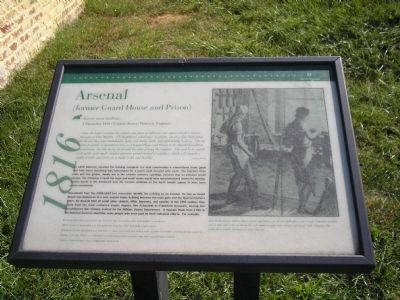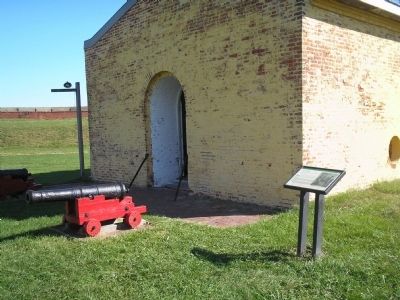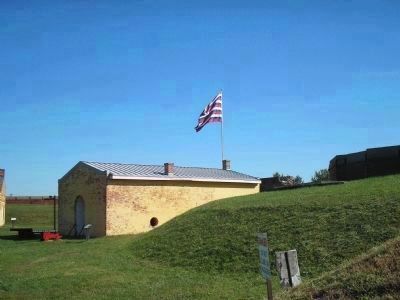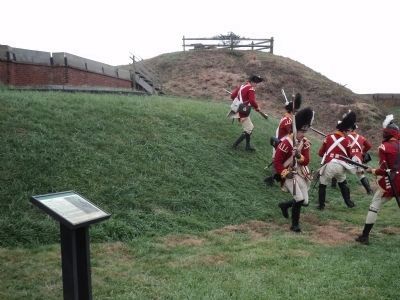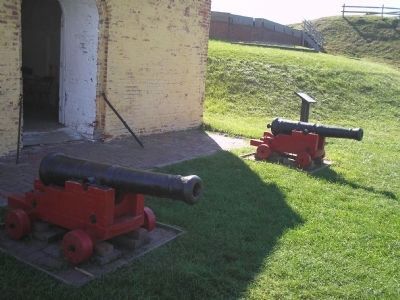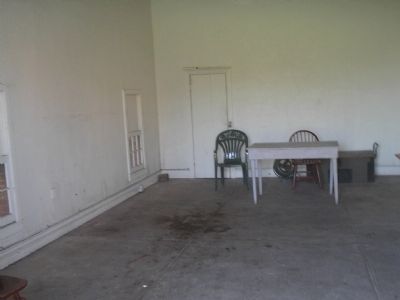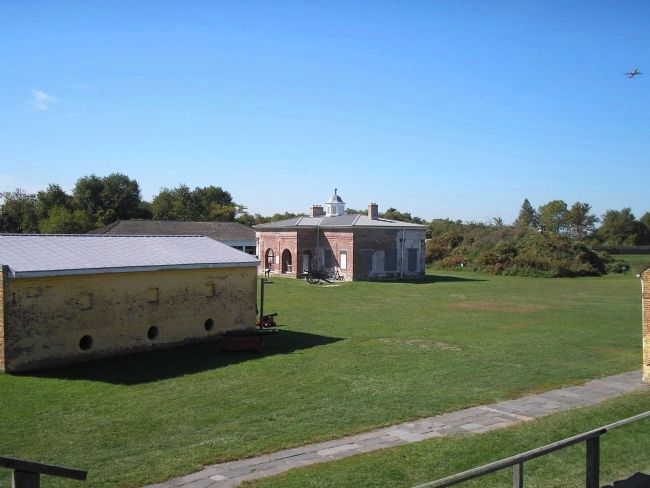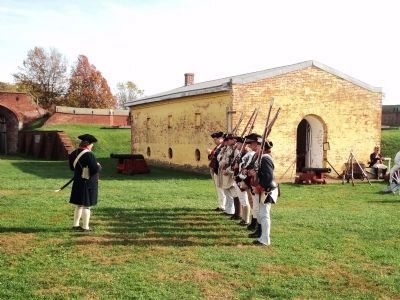Fort Mifflin in Philadelphia in Philadelphia County, Pennsylvania — The American Northeast (Mid-Atlantic)
Arsenal
(former Guard House and Prison)
— 1816 —
Report from the Fort
4 December 1815 • Captain Samuel Babcock, Engineer
I have the honor to enclose an estimate and plans of additions and repairs which I conceive necessary at Fort Mifflin. The Bombproofs which exist at present are in a state little fitted for the uses they were intended for, being very damp, dark, and approaching to decay. The one I have projected is intended to serve as a Guard House and Prison to be situated parallel to the revetment, one side facing the parade the other joining the rampart. The arch to be covered with earth, with small circular apertures grated instead of windows, which will furnish a supply of light and fresh air to make it dry and healthy.
National Archive
By 1816 Babcock reported the building complete. For final construction a conventional frame gable roof with metal sheathing was substituted for a barrel vault covered with earth. The four-foot thick walls and iron grates, deeply set in the circular masonry openings, assured that no prisoner would escape. The chimneys in both the large and small rooms would have accommodated stoves for heating. Square insets in the brickwork over the circular windows on the north façade appear to have been purely ornamental.
Documents from the 1835-1839 fort renovation identify the building as an Arsenal. Its role as Guard House was passed on to a new, smaller frame building between the main gate and the Quartermaster’s Store. An Arsenal held all small arms – pistols, rifles, bayonets, and swords. In the 19th century they came from the main ordnance supply depots, the Schuylkill or Frankford Arsenals. During the Revolutionary War citizens worked for the Military Stores Department. A Voucher Book from 1780 in the National Archives identifies many people who were paid for their individual efforts. Foe example:
Patrick Fottrill received 190 pounds for cleaning and repairing 19 muskets
Mary Lorenz received 225 pounds for making 1800 flannel cartridges
Andrew Kuhn received 305 pounds 17 shillings and six pence for 29 days of work casting musket balls
Daniel Joy received 112 pounds 10 shillings for casting two iron 24 pound cannon, three 18 pounders and a wrought iron gun
Erected by Fort Mifflin Historic Site.
Topics. This historical marker is listed in these topic lists: Forts and Castles • Notable Buildings. A significant historical date for this entry is December 4, 1815.
Location. 39° 52.519′ N, 75° 12.76′ W. Marker is in Philadelphia, Pennsylvania, in Philadelphia County. It is in Fort Mifflin. Marker can be reached from W Fort Mifflin Road, on the right when traveling east. Marker is along the walking tour of Fort Mifflin. Touch for map. Marker is at or near this postal address: 6400 Hog Island Rd, Philadelphia PA 19153, United States of America. Touch for directions.
Other nearby markers. At least 8 other markers are within walking distance of this marker. Quartermaster’s Store (within shouting distance of this marker); Torpedo Casemate (within shouting distance of this marker); Casemates or Bombproofs (within shouting distance of this marker); Soldiers’ Barracks (within shouting distance of this marker); Citadel - 1796 (within shouting distance of this marker); Expert Fishers of Fort Mifflin (within shouting distance of this marker); Artillery (within shouting distance of this marker); What Makes Wetlands? (within shouting distance of this marker). Touch for a list and map of all markers in Philadelphia.
More about this marker. The right of the marker contains a picture of two men working in a gun shop. It has the caption “After the Revolution America offered economic opportunities for all who could offer a craft or a trade. Gunsmiths produced guns in shops such as this one during the 19th century to supply both military and citizen’s needs. Ordnance and gunpowder eventually developed into large industries.”
Related markers. Click here for a list of markers that are related to this marker. This series of markers follow the walking tour of Fort Mifflin.
Also see . . .
1. The Fort that saved America. The Official Website of Fort Mifflin on the Delaware. (Submitted on October 18, 2008, by Bill Coughlin of Woodland Park, New Jersey.)
2. Fort Mifflin Groundplan. Layout of Fort Mifflin, the Fort that saved America. (Submitted on October 18, 2008, by Bill Coughlin of Woodland Park, New Jersey.)
Credits. This page was last revised on February 2, 2023. It was originally submitted on October 18, 2008, by Bill Coughlin of Woodland Park, New Jersey. This page has been viewed 1,069 times since then and 10 times this year. Last updated on March 9, 2021, by Carl Gordon Moore Jr. of North East, Maryland. Photos: 1, 2, 3. submitted on October 18, 2008, by Bill Coughlin of Woodland Park, New Jersey. 4. submitted on November 10, 2013, by Bill Coughlin of Woodland Park, New Jersey. 5, 6, 7. submitted on October 18, 2008, by Bill Coughlin of Woodland Park, New Jersey. 8. submitted on November 15, 2014, by Bill Coughlin of Woodland Park, New Jersey. • Bernard Fisher was the editor who published this page.
